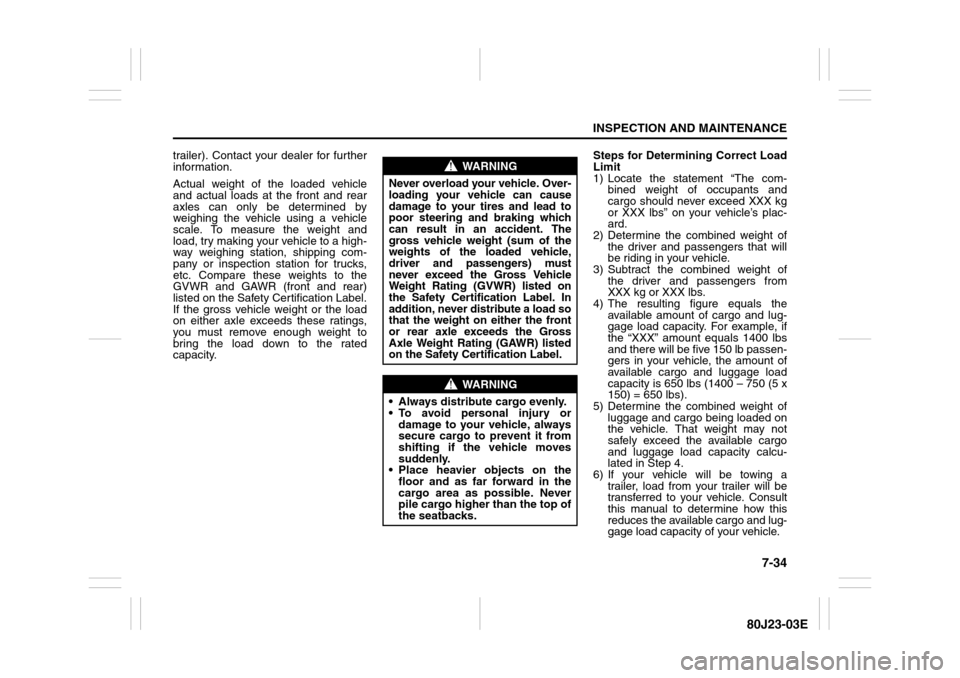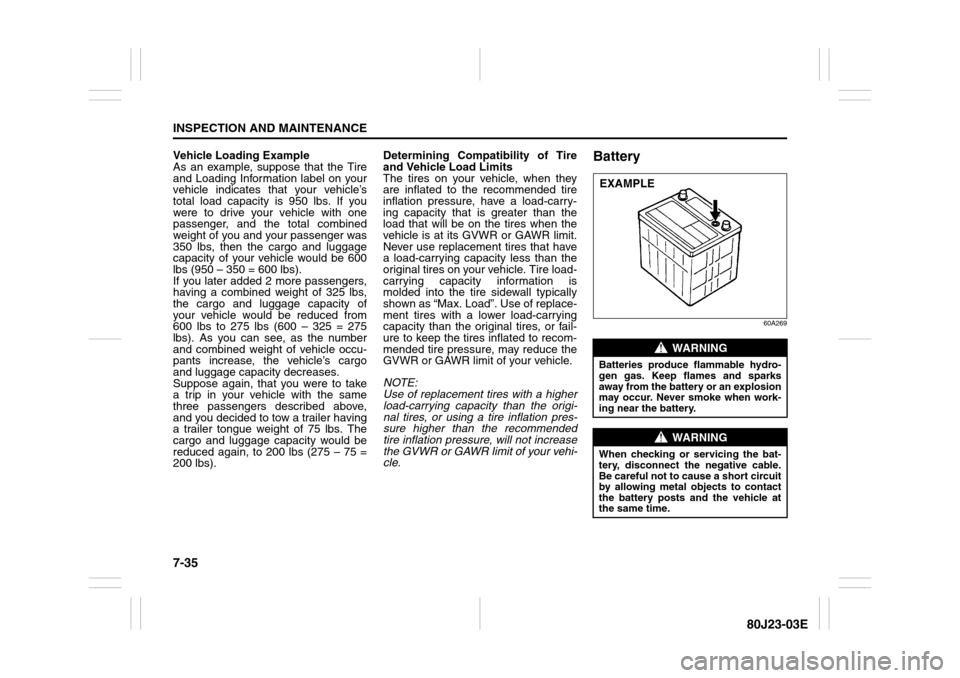2010 SUZUKI SX4 tires
[x] Cancel search: tiresPage 239 of 297

7-34
INSPECTION AND MAINTENANCE
80J23-03E
trailer). Contact your dealer for further
information.
Actual weight of the loaded vehicle
and actual loads at the front and rear
axles can only be determined by
weighing the vehicle using a vehicle
scale. To measure the weight and
load, try making your vehicle to a high-
way weighing station, shipping com-
pany or inspection station for trucks,
etc. Compare these weights to the
GVWR and GAWR (front and rear)
listed on the Safety Certification Label.
If the gross vehicle weight or the load
on either axle exceeds these ratings,
you must remove enough weight to
bring the load down to the rated
capacity.Steps for Determining Correct Load
Limit
1) Locate the statement “The com-
bined weight of occupants and
cargo should never exceed XXX kg
or XXX lbs” on your vehicle’s plac-
ard.
2) Determine the combined weight of
the driver and passengers that will
be riding in your vehicle.
3) Subtract the combined weight of
the driver and passengers from
XXX kg or XXX lbs.
4) The resulting figure equals the
available amount of cargo and lug-
gage load capacity. For example, if
the “XXX” amount equals 1400 lbs
and there will be five 150 lb passen-
gers in your vehicle, the amount of
available cargo and luggage load
capacity is 650 lbs (1400 – 750 (5 x
150) = 650 lbs).
5) Determine the combined weight of
luggage and cargo being loaded on
the vehicle. That weight may not
safely exceed the available cargo
and luggage load capacity calcu-
lated in Step 4.
6) If your vehicle will be towing a
trailer, load from your trailer will be
transferred to your vehicle. Consult
this manual to determine how this
reduces the available cargo and lug-
gage load capacity of your vehicle.
WARNING
Never overload your vehicle. Over-
loading your vehicle can cause
damage to your tires and lead to
poor steering and braking which
can result in an accident. The
gross vehicle weight (sum of the
weights of the loaded vehicle,
driver and passengers) must
never exceed the Gross Vehicle
Weight Rating (GVWR) listed on
the Safety Certification Label. In
addition, never distribute a load so
that the weight on either the front
or rear axle exceeds the Gross
Axle Weight Rating (GAWR) listed
on the Safety Certification Label.
WARNING
Always distribute cargo evenly.
To avoid personal injury or
damage to your vehicle, always
secure cargo to prevent it from
shifting if the vehicle moves
suddenly.
Place heavier objects on the
floor and as far forward in the
cargo area as possible. Never
pile cargo higher than the top of
the seatbacks.
Page 240 of 297

7-35INSPECTION AND MAINTENANCE
80J23-03E
Vehicle Loading Example
As an example, suppose that the Tire
and Loading Information label on your
vehicle indicates that your vehicle’s
total load capacity is 950 lbs. If you
were to drive your vehicle with one
passenger, and the total combined
weight of you and your passenger was
350 lbs, then the cargo and luggage
capacity of your vehicle would be 600
lbs (950 – 350 = 600 lbs).
If you later added 2 more passengers,
having a combined weight of 325 lbs,
the cargo and luggage capacity of
your vehicle would be reduced from
600 lbs to 275 lbs (600 – 325 = 275
lbs). As you can see, as the number
and combined weight of vehicle occu-
pants increase, the vehicle’s cargo
and luggage capacity decreases.
Suppose again, that you were to take
a trip in your vehicle with the same
three passengers described above,
and you decided to tow a trailer having
a trailer tongue weight of 75 lbs. The
cargo and luggage capacity would be
reduced again, to 200 lbs (275 – 75 =
200 lbs).Determining Compatibility of Tire
and Vehicle Load Limits
The tires on your vehicle, when they
are inflated to the recommended tire
inflation pressure, have a load-carry-
ing capacity that is greater than the
load that will be on the tires when the
vehicle is at its GVWR or GAWR limit.
Never use replacement tires that have
a load-carrying capacity less than the
original tires on your vehicle. Tire load-
carrying capacity information is
molded into the tire sidewall typically
shown as “Max. Load”. Use of replace-
ment tires with a lower load-carrying
capacity than the original tires, or fail-
ure to keep the tires inflated to recom-
mended tire pressure, may reduce the
GVWR or GAWR limit of your vehicle.
NOTE:
Use of replacement tires with a higher
load-carrying capacity than the origi-
nal tires, or using a tire inflation pres-
sure higher than the recommended
tire inflation pressure, will not increase
the GVWR or GAWR limit of your vehi-
cle.
Battery
60A269
WARNING
Batteries produce flammable hydro-
gen gas. Keep flames and sparks
away from the battery or an explosion
may occur. Never smoke when work-
ing near the battery.
WARNING
When checking or servicing the bat-
tery, disconnect the negative cable.
Be careful not to cause a short circuit
by allowing metal objects to contact
the battery posts and the vehicle at
the same time.EXAMPLE
Page 294 of 297

13-4INDEX
80J23-03E
Periodic Maintenance Schedule ........................................... 7-3
Power Door Locking System ................................................ 2-2
Power Mirror Control ........................................................... 2-20
Power Steering..................................................................... 7-24
Power Steering Fluid ........................................................... 7-24
Power Window Controls ..................................................... 2-17
Power-Assisted Brakes ....................................................... 3-21RRadio Antenna ..................................................................... 5-15
Rear Seats ............................................................................ 2-24
Rear Window Wiper/Washer Switch .................................. 2-80
Refill with Oil and Check for Leaks .................................... 7-14
Refilling................................................................................. 7-12
Remote Audio Controls....................................................... 5-37
Replace the Oil Filter ........................................................... 7-13
Replacing Tires and/or Wheels .......................................... 3-29
Reporting Safety Defects .................................................... 10-4
Roof Rails or Roof Rack Anchors ...................................... 5-55SSafety Certification Label.................................................... 10-2
Seat Adjustment .................................................................. 2-21
Seat Belt Extender ............................................................... 2-45
Seat Belt Hanger .................................................................. 2-34
Seat Belt Inspection ............................................................ 2-35
Seat Belt Pretensioner System........................................... 2-46
Seat Belt Reminder .............................................................. 2-32
Seat Belts and Child Restraint Systems............................ 2-28
Selection of Coolant ............................................................ 7-14
Shopping Hook .................................................................... 5-51
Shoulder Anchor Height Adjuster ...................................... 2-34
Side Air Bags and Side Curtain Air Bags .......................... 2-50Side Door Locks ..................................................................... 2-1
SLIP Indicator Light .................................................... 2-62, 3-25
Snow Tires ............................................................................ 7-32
Spark Plugs .......................................................................... 7-16
SPECIFICATIONS ................................................................. 12-1
Specified Fluid...................................................................... 7-20
Specified Gear Oil ................................................................ 7-18
Specified Oil ......................................................................... 7-11
Speedometer ........................................................................ 2-68
Spot Light ............................................................................. 5-47
Stability Control System...................................................... 3-24
Starting the Engine ................................................................ 3-8
Steering Wheel ..................................................................... 7-23
Sun Visor .............................................................................. 5-45
Supplemental Restraint System (air bags) ........................ 2-47
TTachometer ........................................................................... 2-69
Tailgate.................................................................................... 2-3
Temperature Gauge ............................................................. 2-70
Theft Deterrent Light............................................................ 2-17
Thermometer ........................................................................ 2-73
Tilt Steering Lock Lever ...................................................... 2-81
Tire Chains.............................................................................. 4-5
Tire Changing Tool ................................................................ 8-1
Tire Inflation Pressure ......................................................... 7-26
Tire Inspection...................................................................... 7-28
Tire Pressure Monitoring System (TPMS) ......................... 3-26
Tire Rotation ......................................................................... 7-30
Tire Sidewall Labeling ......................................................... 7-24
Tire Size ................................................................................ 7-25
Tires....................................................................................... 7-24